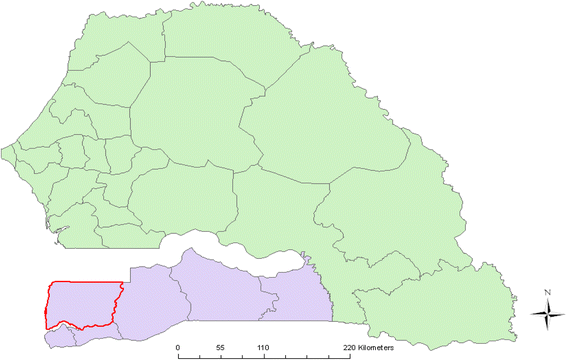Population-based prevalence survey of follicular trachoma and trachomatous trichiasis in the Casamance region of Senegal
- PMID: 28747198
- PMCID: PMC5530574
- DOI: 10.1186/s12889-017-4605-0
Population-based prevalence survey of follicular trachoma and trachomatous trichiasis in the Casamance region of Senegal
Erratum in
-
Erratum to: BMC Public Health, Vol. 18.BMC Public Health. 2017 Sep 22;17(1):736. doi: 10.1186/s12889-017-4709-6. BMC Public Health. 2017. PMID: 28938882 Free PMC article. No abstract available.
Abstract
Background: Trachoma, caused by ocular infection with Chlamydia trachomatis, is the leading infectious cause of blindness worldwide. We conducted the first population-based trachoma prevalence survey in the Casamance region of Senegal to enable the Senegalese National Eye Care Programme (NECP) to plan its trachoma control activities. The World Health Organization (WHO) guidelines state that any individual with trachomatous trichiasis (TT) should be offered surgery, but that surgery should be prioritised where the prevalence is >0.1%, and that districts and communities with a trachomatous inflammation, follicular (TF) prevalence of ≥10% in 1-9 year-olds should receive mass antibiotic treatment annually for a minimum of three years, along with hygiene promotion and environmental improvement, before re-assessing the prevalence to determine whether treatment can be discontinued (when TF prevalence in 1-9 year-olds falls <5%).
Methods: Local healthcare workers conducted a population-based household survey in four districts of the Bignona Department of Casamance region to estimate the prevalence of TF in 1-9 year-olds, and TT in ≥15 year-olds. Children's facial cleanliness (ocular and/or nasal discharge, dirt on the face, flies on the face) was measured at time of examination. Risk factor questionnaires were completed at the household level.
Results: Sixty communities participated with a total censused population of 5580 individuals. The cluster-, age- and sex-adjusted estimated prevalence of TF in 1-9 year-olds was 2.5% (95% Confidence Interval (CI) 1.8-3.6) (38/1425) at the regional level and <5% in all districts, although the upper 95%CI exceeded 5% in all but one district. The prevalence of TT in those aged ≥15 years was estimated to be 1.4% (95%CI 1.0-1.9) (40/2744) at the regional level and >1% in all districts.
Conclusion: With a prevalence <5%, TF does not appear to be a significant public health problem in this region. However, TF monitoring and surveillance at sub-district level will be required to ensure that elimination targets are sustained and that TF does not re-emerge as a public health problem. TT surgery remains the priority for trachoma elimination efforts in the region, with an estimated 1819 TT surgeries to conduct.
Keywords: Active trachoma; Chlamydia trachomatis; Control; Senegal; Survey; Trachomatous trichiasis.
Conflict of interest statement
Authors’ information
Not applicable.
Ethics approval and consent to participate
The research was done in accordance with the declaration of Helsinki. Ethical approval was obtained from the Comité d’éthique du CNRS (National Centre for Scientific Research), Dakar, Senegal. Written informed consent (signature or thumbprint) was obtained from the head of all included households. In addition, written informed consent was provided by each participant, or their guardians if the participant was aged <15 years.
Consent for publication
Not applicable.
Competing interests
The authors declare that they have no competing interests.
Publisher’s Note
Springer Nature remains neutral with regard to jurisdictional claims in published maps and institutional affiliations.
Figures



References
-
- WHO WHO alliance for the global elimination of blinding trachoma by the year 2020. Progress report on elimination of trachoma, 2013. Wkly Epidemiol Rec. 2014;89(39):421–428. - PubMed
-
- WHO . World health assembly. Global elimination of blinding trachoma. 51st world health assembly, Geneva, 16 may 1998, resolution WHA51.11. Geneva: World Health Organization; 1998.
-
- WHO. Report of the third global scientific meeting on trachoma. http://www.who.int/blindness/publications/WORLDHEALTHORGANIZATIONGSMmtgr... Baltimore, 19-20th July 2010.
-
- WHO . Technical consultation on trachoma surveillance, September 11–12, 2014. Technical advisory group on neglected tropical diseases. Decatur: Task Force for Global Health; 2015.
MeSH terms
Substances
LinkOut - more resources
Full Text Sources
Other Literature Sources
Miscellaneous

